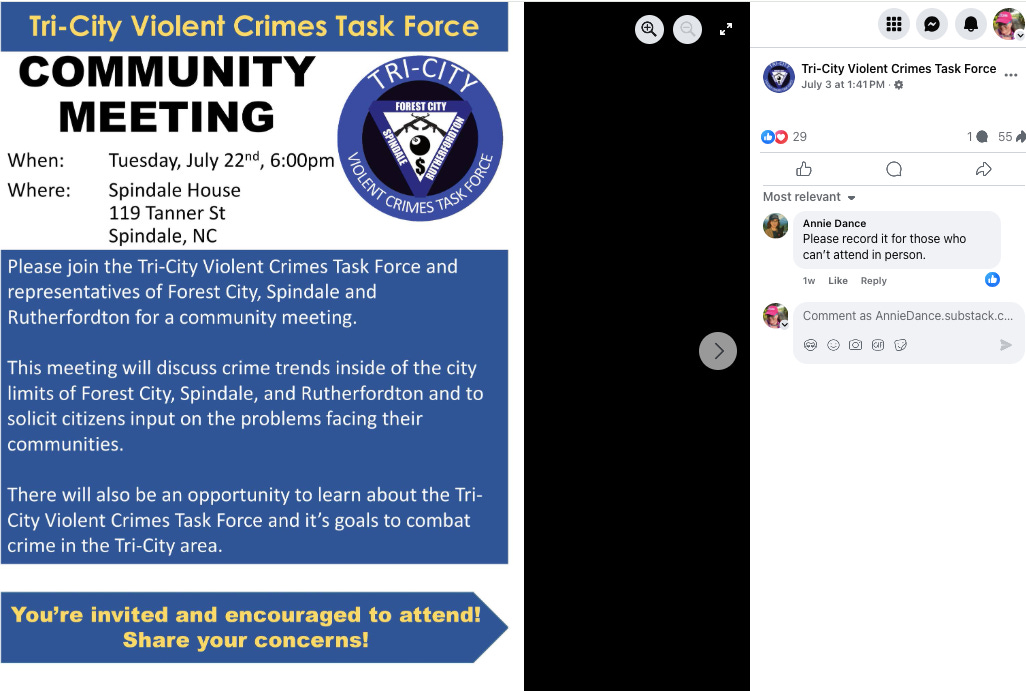Exclusive: Five people are dead, 820 crimes reported—and the public was told almost nothing
A deep look at crime data in Forest City, NC, reveals deaths, drug arrests, and rampant theft—with almost no public communication from FCPD.
This exclusive is supported by readers like you. At Lake Lure News and Cops & Congress, facts come first, followed by clear, thoughtful commentary and original reporting you won’t see anywhere else. Your support keeps local, independent journalism going strong. Your subscription for yourself (or a gift) brings you closer to the decisions shaping the community and ensures I can continue delivering the stories that matter most. Situational awareness: A scoop is exclusive reporting—when no one else is on the story. It’s not just breaking news. It’s journalism with impact.
FOREST CITY, N.C. — Between January 1 and July 9, 2025, the Forest City Police Department filed 820 written incident reports, each documenting a crime or police response serious enough to merit a formal case file.
These incidents include everything from shoplifting and trespassing to drug possession, stolen vehicles, and even death investigations. But in that same six-month period, just 17 press releases or alerts were issued by the department via Nixle, its public alert system.
That means more than 98% of criminal activity and police action in this Western North Carolina town of just over 7,000 people was never shared publicly, including at least five death investigations involving individuals found deceased in residential neighborhoods.
The result is a growing information vacuum where serious crime is occurring, repeat offenders are reappearing, and the public is being told almost none of it.
The Scope of Crime: A Town-Wide Problem
The 820 incident reports, obtained via Southern Software’s Citizen Connect platform and analyzed by Cops & Congress, offer the most complete snapshot to date of Forest City’s criminal activity in 2025. These aren’t just calls for service; they are written case files, meaning an officer responded, investigated, and logged the situation officially.
Here’s what the data shows:
Most Frequent Crime Types:
Larceny/Theft: Over 160 cases, including:
Shoplifting (repeat locations like Walmart, Ingles, and Dollar General)
Larceny after breaking and entering
Gas theft
Employee theft
Theft from a motor vehicle
Trespassing: More than 140 reports, often tied to:
Repeat trespass warnings
Individuals returning to stores or properties from which they’d been banned
Drug-Related Arrests: At least 50 cases, including:
Methamphetamine possession
Schedule IV and VI controlled substances
Drug paraphernalia
Narcotics in vehicles or on persons during unrelated calls
Fraud & Forgery: More than 25 reports, involving:
EBT card fraud
Forged checks
Theft by false pretense
Financial identity theft
Motor Vehicle Crimes: Nearly 30 cases, including:
Stolen vehicles
Recovered stolen vehicles
Breaking and entering of autos
Theft of vehicle parts
Weapons/Firearms: Over 12 cases, including:
Firearm theft
Possession of a firearm by a felon
Discharging a firearm inside city limits
Also notable are scattered reports involving:
Domestic violence
Child endangerment
Runaways and missing persons
Simple and aggravated assaults
Structure fires and unattended deaths
Repeat Locations: The Geography of Crime
Criminal activity was not limited to one area. However, several addresses consistently reappear in the logs, highlighting what law enforcement might call “hot spots.”
Top Locations for Police Calls:
Walmart – 197 Plaza Drive:
62 separate reports over six months, including:Shoplifting
Trespassing
Drug arrests
Stolen/recovered vehicles
Assaults and disorderly conduct
Ingles – 756 S Church Street:
Frequent reports of theft, trespassing, warrants served.Burger King/Roses – 2270 College Avenue:
Drug offenses, disturbances, property damage.McDonald’s – 134 Oak St Ext:
Multiple drug possession arrests, trespassing cases.Storage Depot – 903 W Main Street:
Firearm theft, vehicle break-ins, larceny.Food Lion – 668 S Broadway St:
Theft, drug arrests, repeat trespassing.Other high-frequency residential areas include:
Poplar Street
Harmon Street
Knollwood Drive
Dillashaw Drive
Valleyview Drive
Crime happened across the town, north and south, residential and retail. It wasn’t concentrated in one zip code or neighborhood. It was woven into the everyday fabric of Forest City.
Five Deaths, No Public Word
The most disturbing finding from the Cops & Congress data review is that five people died in Forest City during the reporting period—and not one of those deaths was ever mentioned in a press release or public alert.
Here are the cases, all marked “Death Investigation” by police:
181 Schneider Drive – January 25
375 Harmon Street, Apt 20 – April 4
275 Knollwood Drive – April 21
182 Barbara Street – May 13
131 Valleyview Drive – June 4
Each of these cases involved an individual found deceased, and the circumstances were unclear enough for police to open a formal case.
The causes of death have not been disclosed. One, on Barbara Street, was described as a possible suicide. The others didn’t say if they were natural, accidental, overdose-related, suicides, or homicides. We only know that officers responded and filed a report.
No basic updates. No confirmation that “no foul play is suspected.” No word for families or neighbors. Just silence.
Press Releases: 820 Cases, Just 17 Alerts
In contrast to the 820 reports filed, Forest City Police issued just 17 Nixle alerts from January to July 9. These included:
But none of the death investigations appeared. Neither did many of the robberies, assaults, property crimes, or fires. As a result, the average resident—unless reading raw police records—has no idea what is happening in their town.
A Broader Pattern—and a Local Exception
It’s important to be fair: Forest City isn’t alone in this. Rutherfordton, Spindale, and the Lake Lure Police Department do not even use Southern Software, meaning zero public incident reports are available for that department. There’s no public case tracking platform, and no consistent alerts.
But there is a glimmer of hope nearby: the Rutherford County Sheriff’s Office has a mobile app that provides up-to-date arrest reports and inmate information, and they release information regularly on Facebook. While it doesn’t solve every transparency issue, it’s proof that modern, open communication tools can and should be deployed—even in small rural counties.
Opinion & Analysis: Cops & Congress commentary
If Government Is Silent, Who’s Watching?
From a conservative standpoint, this should raise red flags. We pay for our police departments. We elect our town officials. We live in the communities where these crimes occur. It is not too much to ask for basic communication about serious events, especially death investigations.
Transparency doesn’t mean telling us everything. But it should mean telling us something. Five people died. We don’t know why. That’s not good enough.
In an era where trust in institutions is fraying, it’s the small towns that have the most to lose from bureaucratic silence. If law enforcement leadership won’t even acknowledge a death, how can we trust them to communicate when something bigger happens?
And what about the families? The neighbors? The residents who saw the flashing lights and still have no idea what happened?
When the government stops talking, it sends a message: You don’t need to know.
But we do. We always have.
I also find it curious why Forest City PD did not acknowledge the RCSO memorial ceremony (read more and watch the exclusive video here).
What Needs to Change?
Forest City, like many towns, needs a reset on how it handles public information. Some solutions are simple and cost nothing:
Weekly incident summaries posted online with details that are in line with public records laws
Nixle alerts for any death investigation, even if no foul play is suspected
Crime maps that show where and how often reports are being filed (to be fair, FCPD / southern software does show some of this on their maps)
Quarterly public safety briefings with town council and residents that are recorded and immediately released on the agency’s website or Facebook / YouTube for those who can’t attend in person (to be fair, one is planned for Tuesday, but has not been advertised that it will be recorded, and I have another commitment that day).
None of these threatens police effectiveness. All of them empower the public to be informed and engaged.
A Final Note from the Reporter
This report is based entirely on publicly available data. Cops & Congress does not have the staffing or funding to chase down every police chief for comment or file weeks of public records requests.
This is the story the numbers tell. And unless someone starts filling in the blanks, it’s the only version the public gets.
—
Annie Dance is the publisher of Cops & Congress, a newsletter that tells the truth about what happens when disaster, democracy, and small-town policies collide.




